The Art Studio's Favorite Materials
One of the best things about my job is trying out new art materials. There’s nothing like opening up a fresh box of something colorful, taking in its distinct scent, and dragging it across a piece of paper for the first time. I feel like a scientist, getting ready to embark upon a series of experiments with my students. How will they test the limits of the material? Will they enjoy its smell and texture as much as I do? Since The Carle’s opening in 2002, The Art Studio has been able to test many materials, discovering which stand up to the creative rigors of the thousands of children and adults who visit each year, and which do not.
Some materials we come back to again and again because they continually meet our high standards of quality, value, safety, ease of use, visual feedback, potential for open-ended use, and of course fun for our guests of all ages. The list below does not include ALL the materials we love, but those basics which we find ourselves recommending again and again. By no means are all or any of these required to help a child develop creative habits of mind. A few basics and a willingness to let them be tried and tested in multiple ways will go a long way. As the adult in your learning environment, think of yourself as a co-learner, rather than a provider of answers and supplier of lots of fancy supplies, and you will find joy and discovery in the very important job of helping a child grow and learn.
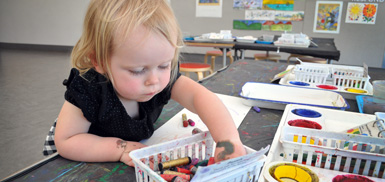
Starting a collection of materials from scratch? In my opinion, quality does matter, so start with a small selection of basics, the best you can afford. Higher quality materials yield better visual feedback and therefore, help sustain a child’s (or anyone’s for that matter) interest in them. The more we work with a material, the more we learn from our experience with it. Finally, a note on safety. All of these materials are non-toxic and have age recommendations on their packaging (minus the found materials). Avoid choking hazards if that’s where your children/students are developmentally, but with supervision young children are capable of experimenting with most of these. That said, you know your children best.
Drawing Tools
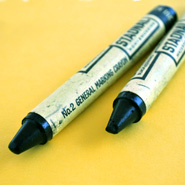
Large Black Crayons
Staonal are great basic drawing tools. The large size holds up well. Peel off the paper for creating wide marks with the side of the crayon. We often use these crayons in mixed media projects like watercolor resist, or for warm-up/ idea generation drawing with a variety of age groups. Find them at Nasco.
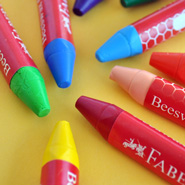
Beeswax Crayons
Some of the large wax crayons out there are so hard they require really firm hand pressure to make vivid marks, making them less-than-ideal for young children. We like the softness and vibrancy of Faber-Castell beeswax crayons as they work well for all ages and are a more budget friendly brand. Beautiful for any drawing exploration, they work especially well when doing wax resist artworks. Find them at Nasco, Dick Blick and School Specialty.
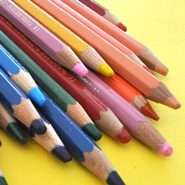
Large Colored Pencils
We love our Prang Large Triangular and Lyra Giants. These two brands offer vivid color, work well on colored paper, and don’t create dust when you draw. They also require less sharpening as they are large. In The Studio we have used colored pencils in many drawing projects like Mapping Makeover and Doodle Flip Books. Find Prang Large Triangular Colored Pencils at Dick Blick. Find Lyra Color Giants at Nasco and The Carle’s Bookshop.
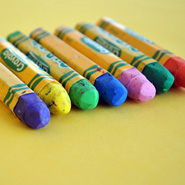
Oil Pastels
We love the range of colors in the Crayola sets. The colors blend well when overlapped, allowing for discoveries through color mixing experiments. Oil pastels are great for resist work like in our Monster Mash Workshop, as well as for drawing on textured paper. Find Crayola Oil Pastels at Nasco, Dick Blick, and School Specialty.
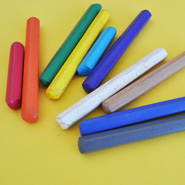
Crayola Color Sticks
A solid stick of color that can be used like a colored pencil with the added possibility of using the side for broad marks. They don’t break easily and hardly ever wear down so they are ideal for their durability. Some teachers I’ve met even like to break them in half to share a complete set between two students. Find them at Nasco and Dick Blick.
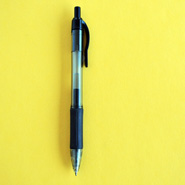
Black Gel Pens
Another great basic drawing tool, gel pens glide smoothly and make a rich mark. You can get them in different mm sizes for a variety of line widths. Gel pens can be used to inspire stories and are a great bridge between story writing and illustrating. We also use gel pens in mixed media projects like Watercolor with Words. Find Zebra Sarasa gel pens at Staples and Nasco.

Washable Markers
Kids are magnetically drawn to markers’ bold marks and saturated colors. In my experience, Crayola’s sturdy design held up better in The Art Studio than others we’ve tried. Some of the ways that we have used markers in The Studio can be found in: Winter Snow Painting and Bookmaking with Kindergarteners. Find them everywhere. Here are some links: Nasco and Dick Blick.
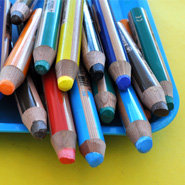
Stabilo Woody 3-In-1 Multi-Talented Pencils
These are a bit of a splurge but very much worth it! They sharpen like pencils, glide like creamy eyeshadow, and create washes when you go over marks with a wet brush. They’re sort of like a watercolor crayon in thick pencil form. The colors are rich and satisfying. Tou can even use them on non-porous surfaces like windows and mirrors and wipe them off without issue with a wet cloth! Find them at Dick Blick.
Paper and Scissors
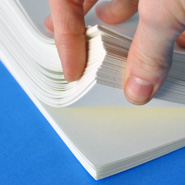
Bright White Sulphite Drawing Paper
Lots of companies make a fine drawing paper. We like the heavy weights (60#, 80#) because they can take some wet media, work well for paper construction, and are a great drawing surface too. We had many drawing surface choices using Bright White Sulphite Paper for our Drawing Day. Here are just a few more examples of how we’ve used drawing paper: Outdoor Drawing, Drawing with Illustrator Pamela Zagarenski, and Doodle Flip Books. Find Bright White Sulphite Drawing Paper in reams (500 sheets) at Nasco and Dick Blick.
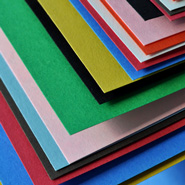
Tru-Ray Contruction Paper
Though we enjoy experimenting with all kinds of papers, this is our most used colored paper. It’s bright, cuts and folds well, and handles a variety of drawing media well too. Here are some of the many uses we have found for this paper: Layered Paper Sculptures, and Collage Birds. Find Tru-Ray Construction Paper at Nasco, School Specialty, and Dick Blick.
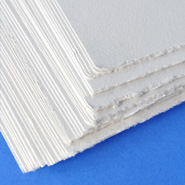
Nasco Student Watercolor Paper
When we want to use wet media or collage on something heavier than drawing paper, we like to use watercolor paper. Nasco makes a student grade that has a nice tooth (surface texture). We usually cut the whole pack of 20” x 30” paper into quarters, giving us 400 sheets per pack. Watercolor paper can be expensive, so this kind is a good value for the amount we use. Many of our painting projects use this versatile paper: Watercolor with Words, and Inkblot Creatures. Here is an earlier post with some more information about Watercolor Paper. Find Nasco’s Student Watercolor Paper on their website.
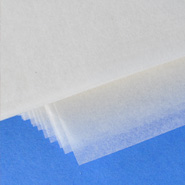
Tracing Paper
Tracing paper is for more than just tracing! We like to use it as a stand-in for white tissue paper when we do Eric Carle-inspired projects. One of our popular window shades can be made with tracing paper to look like our Rainbow Window Shades. We have also used tracing paper for Leafy Critter Books. Find 9” x 12” reams at Nasco, and pads of various sizes at Dick Blick.
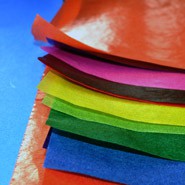
Folia Transparent Paper
Sturdier and more fade resistant than tissue paper, it’s alot like glassine, if you’re familiar with that. This is another great paper for Eric Carle-Inspired collage projects and we’ve used this paper for Rainbow Window Shades too. I haven’t yet found paper just like this made by anyone else, but it’s a favorite of our guests, so it’s worth including it here. Find it in 100 19.75” x 27.5” sheet rolls at School Specialty.
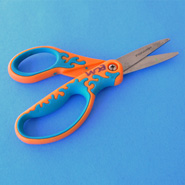
Kids Scissors
Fiskars Softgrip Kids Scissors come in Precision-Tip (they aren’t super pointy) and Blunt Tip. The pair pictured here are a slightly different from how they’re made now (slightly larger handles, different colors). Here are a few projects that we used these scissors for: Collage Birds, and Rainbow Stick-and-band Books.
Adhesives
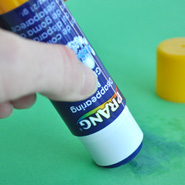
Prang Washable Colored Glue Sticks .74 oz.
We’ve been using these glue sticks for about 10 years. The larger size glue sticks don’t break as easily as the small ones when turned way up, and they don’t dry out as quickly either. The color makes it easy for kids, or anyone for that matter, to see where the glue was put and dries clear. See how we’ve used glue sticks in a few of The Art Studio’s projects: Show Me a Story, and Collage Birds. Find them at Nasco and School Specialty.
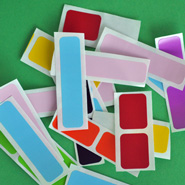
Color Coding Dots and Labels
Library color coding dots labels make great open-ended stickers and fasteners. They come in a range of shapes and colors on rolls in dispenser boxes. We usually cut them into groupings of 2 or 3 when we offer them in the studio. Avery (or other brand) color-coding dots from an office supply store are a great alternative. These dots and labels are especially useful when making tabs and flaps in pop-up books like in our Bookmaking with Second Graders. Here are Demco’s Color - Coding Dots and Color-Coding Labels. Find Avery labels at Staples.
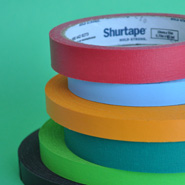
Colored Masking Tape
Colored masking tape is a great tool for paper construction, and Shurtape is our favorite brand because it has the best adhesion. We’ve used tape as a colorful adhesive in Doodle Flip Books and mobiles including Andy’s Plant-Inspired Special Sunday Project. Find colored making tape in a variety of sizes at Tape Solutions Inc.
Paint and Brushes
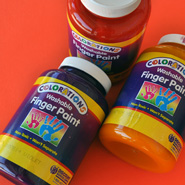
Washable Finger Paint
Finger paint is a recent addition to The Art Studio. After talking with early childhood educators and reading product reviews, I was confident that Discount School Supply’s own Colorations brand was the way to go. We’ve used it a few times with groups of toddlers in the studio, plenty with my own toddler at home, and I’m really pleased with it’s color vibrancy (on drawing paper) and washability. Find Colorations Washable Finger Paint at Discount School Supply.

Washable and Premier Tempera
We’ve tried a lot of temperas over the years. We like washable tempera for our offsite programs and when working with young children. The non-washable varieties are more opaque and the colors don’t look drastically different when they dry. Lately, Crayola has provided the most consistent formula and best range of colors for learning about color mixing. There are many painting activities in which we’ve used tempera paint, but a few recent faves are Making Nature Faces, and Materials Play in the Morning using tempera and marbles. We also use tempera for printmaking and you can see how to Make Your Own Stamp Pad. A few more ideas using tempera as printing ink can be found at these links: Monotype Printmaking and Roll With It!. Find Crayola Washable Tempera at Nasco, Crayola Premier Tempera at Nasco and Dick Blick
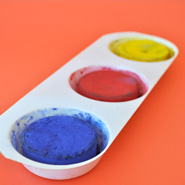
Tempera Cakes
The large size of these dry tempera cakes is ideal for young hands just learning the watercolor process. They can be used transparently like watercolor, or made fairly opaque. We cut the trays in half and usually offer only the primary colors so that the user has to mix to make other colors. You can order tempera cake packs in single colors, which is convenient for large group and classroom settings. See a few of the ways we’ve used tempera cakes in these links: Shadow Play, Drawing Day, and Self-Portrait Paintings. Find Jack Richeson tempera cakes at Dick Blick and School Specialty.
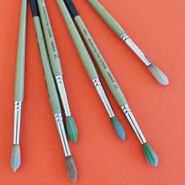
Large Round Synthetic Paint Brushes
We really like our Nasco “Pro-formance” Synthetic Rounds. The firm yet flexible bristles hold up to the enthusiasm and less-refined fine-motor skills of young hands. The super-soft natural brushes that often come with watercolor paint sets are easier for kids to scrub on the paper, leading to holes in the art and splayed brush hairs. A synthetic round brush is worth the investment. The sizes we used most are 8 and 12 or 14. A few of our painting projects that used these brushes can be found here: Watercolor with Words, Monster Mash, and Flower Drawings. Find “Pro-formance” round brushes at Nasco.
Other Favorite Materials
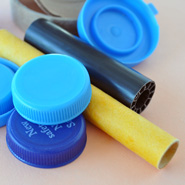
Found Materials
Natural and Man-Made - Last, but definitely not least! This entire post until now has been dedicated to materials that must be purchased. Some of our guests’ favorite projects have been with found and every-day materials that we’ve collected and gathered for FREE. There is a lot of learning that happens through tinkering with objects. Found materials are everywhere. Look in your recycling. Take a walk. Don’t pick up things that pose a safety hazard, and whenever possible, wash object before adding them to your materials supply.
So there it is! Of course, there are many more materials we like, and this list will likely change over time as we continue to test materials and as manufacturers adjust their processes. We hope it’s helpful to you. What kinds of materials do you rank in your favorites? Which do your kids or students come back to again and again? Many thanks to Sarah for helping me pull this post together!

